***This post is a part of my series where this year I will be highlighting all of the different states native frogs and toads. Check out this page to see all of the United State’s native frogs broken down by state. ***
Here are the frogs and Toads that can be found in Utah:
American Bullfrog (Rana catesbeianus)

The American Bullfrog is the largest frog in North America. They can grow up to 8″ in length and weigh up to 1.5 pounds. The bullfrog is unique as it can be found in freshwater ponds, lakes and marshes throughout Canada, United States and as far south as Mexico and Cuba. They are typically green or gray-brown with brown spots. The American Bullfrog can be found statewide. They are currently found in many low elevation areas and live in lakes, ponds generally in the water or on the shoreline.

It has a very deep call which resembles the mooing of a cow. Watch the video below to hear! Both genders of the bullfrog croak. Their calls may be heard day or night between June-July.
Northern Leopard Frog (Rana pipiens)

The Northern Leopard frog has 2-3 unevenly spaced rows of irregular oval shaped dots on its back. The northern leopard frog can be found statewide in mountains and lowlands, however the numbers appear to be declining. It needs 3 different habitats to match its lifestyle – permanent water for overwintering, floodplains & marshes for breeding & meadows and fields for foraging.

These frogs are opportunistic feeders, meaning that they will eat anything that fits in their mouth including beetles, ants, smaller frogs – including their own species, birds and even garter snakes. It’s call is like a low and rumbling snore and grunt sound. It has also been known to scream loudly when grasped or frightened by a predator. Listen below to their call.
Relict Leopard Frog (Rana onca)

The Relict Leopard frog has not been seen in Utah since 1950. It was believed to be extinct until 3 populations were found in Nevada in the 1990’s.

Canyon Tree Frog (Hyla arenicolor)

The Canyon tree frog measures an average of 2″ in length. They only occur along the rocky stream courses within canyons. They can be seen basking on rocks or hiding in crevices. The canyon tree frog may be found within the southern portion of Utah.

The canyon tree frog will breed in pools alongside of the streams primarily in spring, but have been known to breed after heavy summer rains as well. This frogs call sounds like a machine gun, engine turning or a woodpecker drumming. It is a loud, nasal, rapidly stuttering ah-ah-ah. This usually lasts 1-2 seconds.
Western Chorus Frog (Pseudacris triseriata)

The western chorus frog is known for its dark stripe on the side of the body which extends from snout to groin. The sides of its body can range between green – brown – reddish. These frogs can be found throughout central and northeastern Utah.

The western chorus frog makes a preeeeep sound that will ascend in pitch. Listen to the call below!
Green Frog (Rana Clamitans)

The Green Frog is typically greenish-brown with dark mottling on its head, chest and under its legs. The throat color ranges to yellow for a male to white for the females. This frog is common to eastern North America, but has been introduced into the western portions of North America, including Utah. They will be found in permanent or semi-permanent bodies of water.

These frogs can produce as many as 6 different calls – however the most distinctive sound is a throaty boink that sounds like a loose banjo string being plucked. Listen to the video below to hear!
Columbia Spotted Frog (Rana Luteiventris)
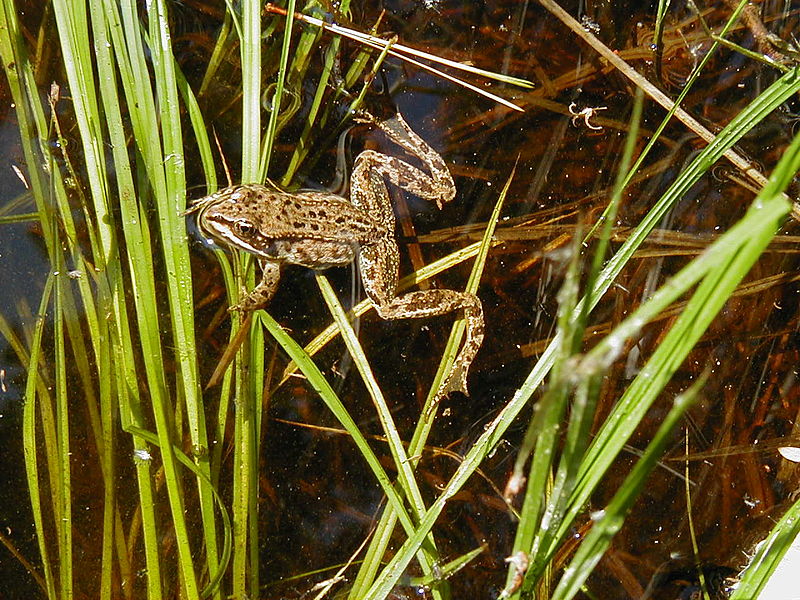
The Columbia Spotted frog has slightly bumpy skin that is smooth and moist. They are typically brown or olive color with irregular spots. They are known for their lower abdomen being bright salmon or a red color. This frog is high aquatic and can rarely be found far from a permanent water source. Isolated populations are found in the West Desert and along the Wasatch Front, however habitat loss has lead to a decline in population and the addition of the Columbia Spotted Frog onto the Utah Sensitive Species List.

The call of the columbia spotted frog is a clucking noise and sounds like the clicking of your tongue on the roof of your mouth. Listen to the video below and around 52 seconds you can hear the frog calling.
Arizona Toad (Bufo microscaphus)

The Arizona toad is typically 2-3/4″ in length and can range in color from a brown to a greenish grey with a light stripe across its head. They can typically be found in streams, reservoirs and uplands adjacent to water. In Utah, they are found in the southwestern portion of the state.

The Arizona toad will lay its eggs on the bottom of shallow, slow moving streams. It is unique that the adult toads are nocturnal, however the young are active during daylight.
Great Plains Toad (Bufo cognatus)

The Great Plains Toad has numerous warts and prominent ridges on its head. The females will typically reach 4.5″ with males being less than 4″. They can be found in grasslands, sandhills and semi-desert shrubland. The Great Plains toad can be found scattered throughout the state.

The Great Plains toad has a long trill call that lasts several seconds long and can vary depending on the size of the male and the temperature. Some people have compared this toad’s call to a jackhammer, but go ahead and listen to it for yourself below:
Western Toad (Bufo boreas)
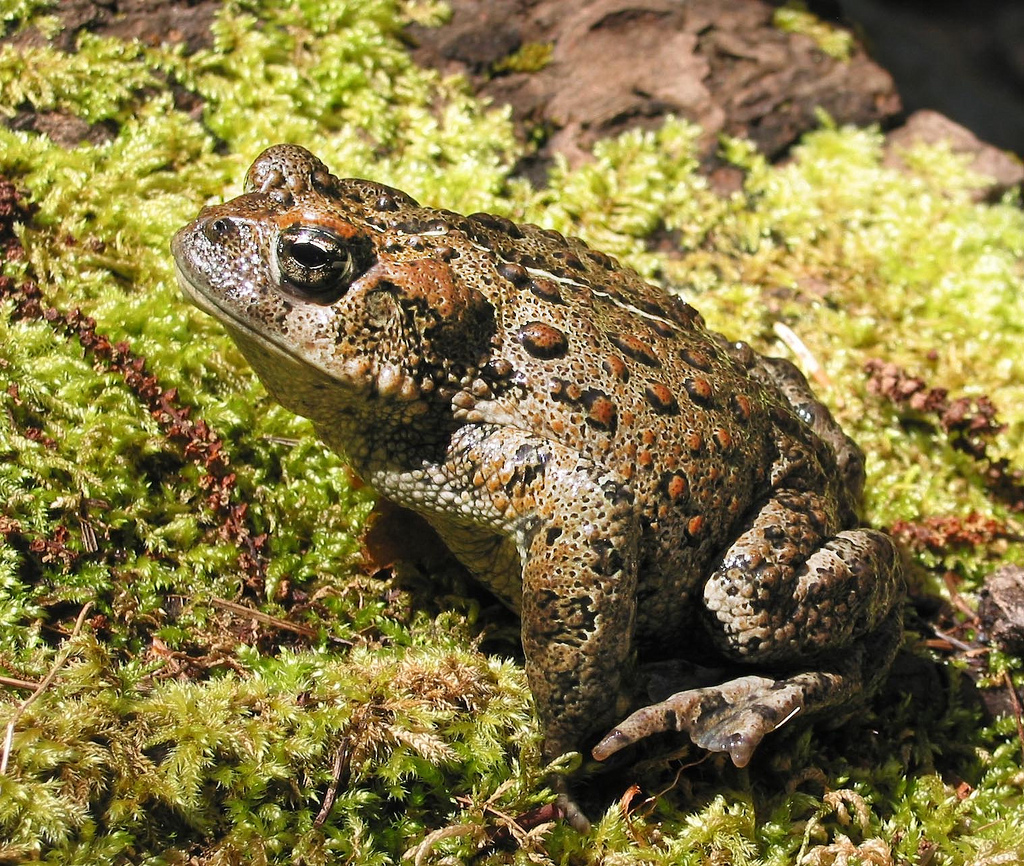
The western toad is chunky, with short legs and numerous warts (it is a toad after all). It can vary in color from brown to green or gray with white and dark mottling on its tummy. There is a conspicuous light colored stripe running down the middle of its back. Their back feet have 2 large rubbery knobs on the heel which they use for digging. The western toad can be found throughout Utah and lives in a variety of habitats including slow moving streams, wetlands, ponds, lakes, etc.

Their call is a soft birdlike clucking call. Listen to it in the video below. When handled, the toad may emit a twittery sound, puff up and urinate. These toads are active during daylight hours and are much more active during damp weather. The western toads population numbers have been declining for unknown reasons; even while in relatively pristine conditions.
Red Spotted Toad (Bufo punctatus)
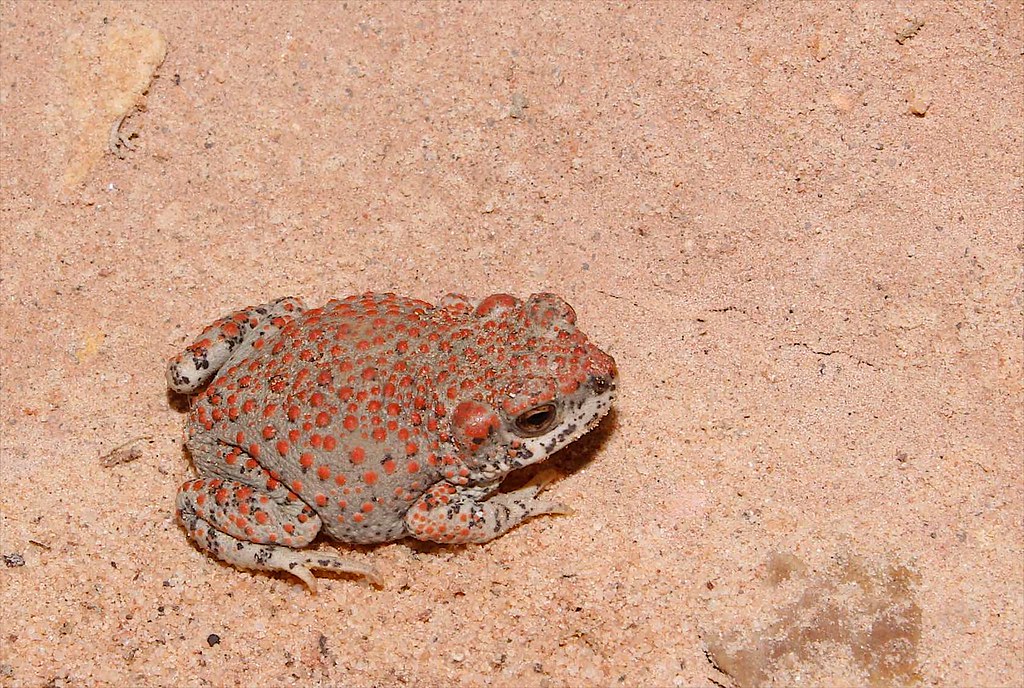
The red-spotted toad is unique due to its gray or brown coloring and red/orange warts. They can reach 3″ in length and can be found in rocky canyons and streams or burrowing under rocks. Typically found in southwestern Utah.

The red-spotted toad has an unusually high pitched trill which can last 3-12 seconds. During the breeding season, the males throat color may darken.
Woodhouse’s Toad (Bufo woodhousii)

Woodhouse’s toad can vary in color from yellowish brown to greenish grey with a light stripe down the middle of its back and can reach up to 5″ in length with the males being smaller than females. These toads can be found primarily in deep soils in river valleys and flood plains. They burrow into soil to escape drought and cold. Woodhouse’s toad is common and can be found statewide.

These toads breed from April to June in marshes, rain pools and other areas lacking strong current. This toad’s call is a loud wahhhhhh lasting between 1-4 seconds and emitted several times a minute.
Plains Spadefoot (Spea bombifrons)

The Plains spadefoot is known for its vertically elongated pupil and markings similar to a hourglass on its upper sides. The plains spadefoot spends most of its life buried in the soil, but will emerge to breed after heavy rains in spring or summer. They can be found in sandhills, grassland and the plains of the southeastern corner of Utah.

The call of the plains spadefoot is a brief snoring sound. Take a listen below.
Great Basin Spadefoot (Spea intermontana)
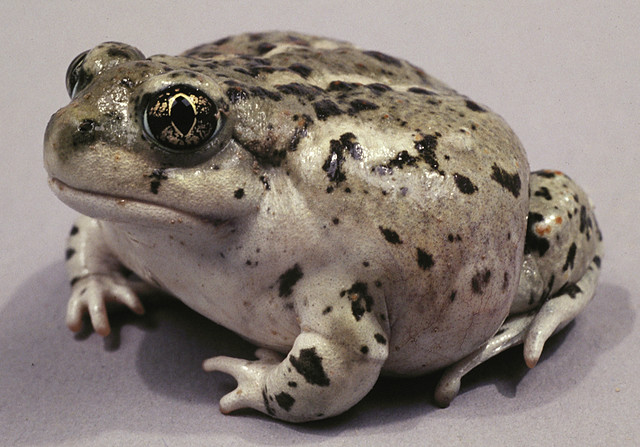
Similar to the Plains spadefoot, the Great Basin spadefoot has a vertical pupil as well. They can be greenish, gray or brown with a scattering of darker spots and blotches. Each spadefoot has a wedge shaped spade on their hind feet, hence the name. They can be found in pools and ponds or flooding in basins across Utah. They are locally common but seldom seen as they spend most of their life buried under the soil.

Their call is a very nasal waaaaa sound. Listen to it below:
Mexican Spadefoot (Spea multiplicata)

This spadefoot is similar to other spadefoots with vertical pupils, wedge spade on its back feet. It can be gray or brown with numerous dark spots reaching up to 2.5″ in length. They can be found in SE & SW Utah in grasslands or semi-desert shurbland.

The New Mexico spadefoot’s call is a stuttering croak that varies in length and duration with increased temperature.
Pacific Treefrog (Pseudacris regilla)
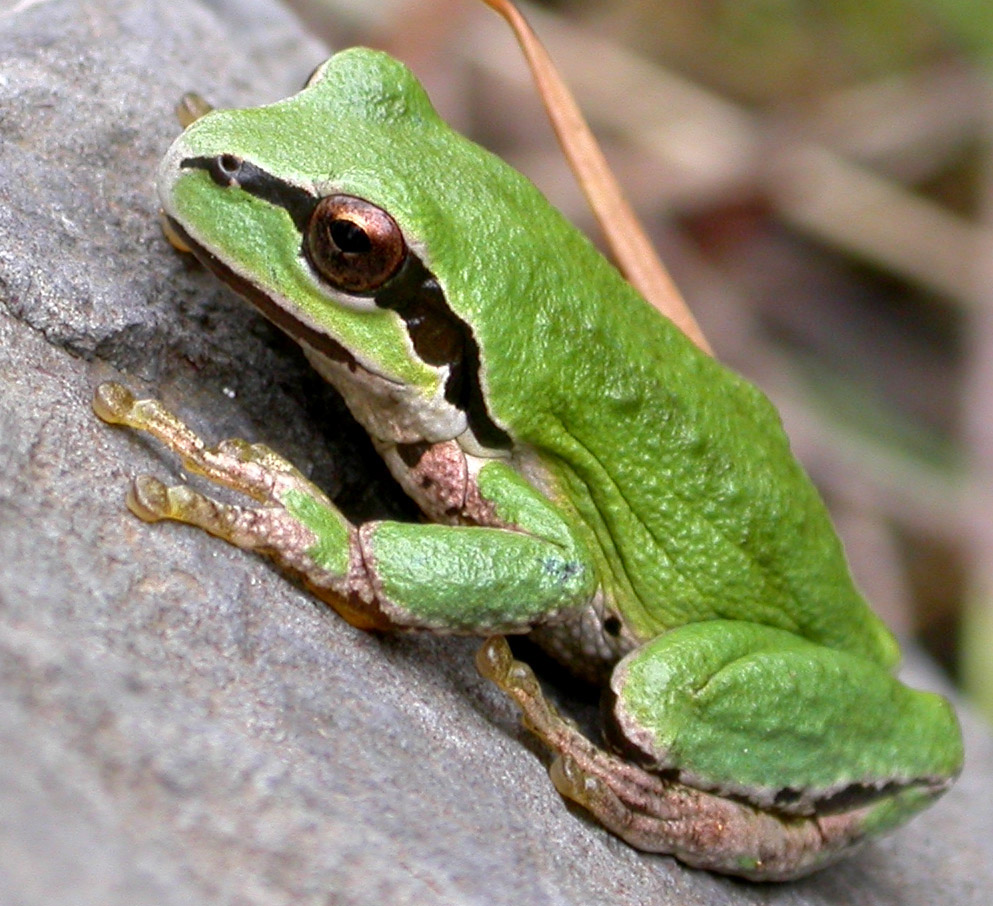
Adult pacific treefrogs have a dark band extending from the shoulder to the nostril. The frogs back color may vary between green, brown, gray, reddish or bronze. Frogs may reach 2″ in length. The pacific treefrog may be found on ground or in low shrubs, dense vegetation and under rocks. In Utah, they have been found in Washington county, Box Elder County and Weber county. It is currently unknown whether they are still in all of those counties or not.

The pacific treefrog has a two part Kreek-eeck call. Listen to it below:
Thanks for reading! Check out all of the United State’s native frogs and toads here.

Photo Credits:
Cover photo used by the CC0/public domain license. Text was added. See Original photo here.
- Photo from Wikimedia Commons used under the Creative Commons license. Photo taken by Brian Gratwicke. Original Photo Here.
- Photo from Wikipedia Commons used under the Creative Commons license. Photo taken by Brian Gratwicke. Original Photo Here.
- Photo from Wikimedia Commons used under the Creative Commons license. Photo taken by Mary Cynthia Dickerson. Original Photo Here.
- Photo from Flickr Wikimedia Commons used under the Creative Commons license. Photo taken by Kerry Matz. Original Photo Here.
- Photo from Flickr Wikimedia Commons used under the Creative Commons license. Photo taken by Todd Plerson. Original Photo Here.
- Photo from Flickr Wikimedia Commons used under the Creative Commons license. Photo taken by Brian Gratwicke. Original Photo Here.
- Photo from Wikimedia Commons used under the Creative Commons license. Photo taken by Forest Service Northern Region. Original Photo Here.
- Photo from Flickr Wikimedia Commons used under the Creative Commons license. Photo taken by Kerry Matz. Original Photo Here.
- Photo from Wikimedia Commons used under the Creative Commons license. Photo taken by Galactor. Original Photo Here.
- Photo from Flickr and used under the Creative Commons license. Photo by Oregon State University. Original photo here.
- Photo from Flickr Wikimedia Commons used under the Creative Commons license. Photo taken by Lon & Queta. Original Photo Here.
- Photo from Flickr Wikimedia Commons used under the Creative Commons license. Photo taken by J.N. Stuart. Original Photo Here.
- Photo from Flickr Wikimedia Commons used under the Creative Commons license. Photo taken by Stanley Trauth. Original Photo Here.
- Photo from Flickr Wikimedia Commons used under the Creative Commons license. Photo taken by Kerry Matz. Original Photo Here.
- Photo from Wikimedia Commons used under the Creative Commons license. Photo taken by Sarah Beckwith. Original Photo Here.
- Photo from Flickr Wikimedia Commons used under the Creative Commons license. Photo taken by Francis Eatherington. Original Photo Here.
For more information:
- https://dwrcdc.nr.utah.gov/rsgis2/search/SearchSelection.asp?Group=AMPHIBIA&Species=VERT
- http://utahherps.info/
Like “The Frog Lady” on facebook or follow aapanaro on instagram to get some sneak peeks into the frog lady’s frog room!


Love it!